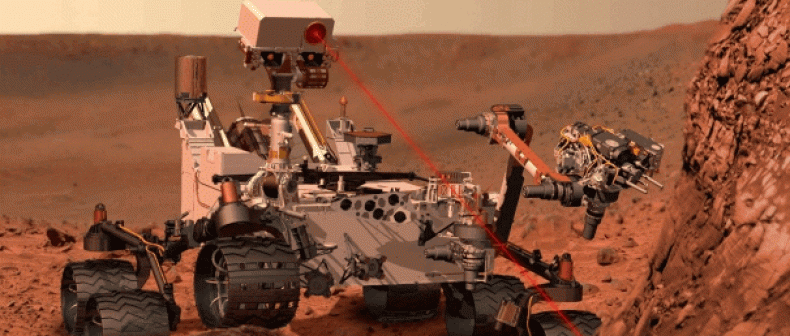
The latest images of the Curiosity Mars rover show a silver capsule from above making its descent to the red and dusty planet below. Little did we know at the time of the image, the circular dish-like object was plunging through Martian atmosphere at 20 times the speed of sound and withstanding temperatures that hovered around 1,600 C.
We know the rest. If you missed it, watch NASA’s animation of the landing here. It landed guardedly and so began the two-year mission to assess whether Mars is, or ever was, capable of supporting microbial life. Doing the grunt work on the ground is the micro-sized rover; it’s equipped with a plethora of gadgets and is armed like a mobile laboratory. One of the tools on board (and one of the keys to the mission) is the Canadian-made Alpha Particle X-Ray Spectrometer (also known as APXS), a small device that sits at the end of Curiosity’s arm to measure various chemical elements in Martian rocks and dirt. It’s the size of a small box, but can something so small be the future of searching for life on Mars and other planets?
Dr. Ralf Gellert, from the department of physics at University of Guelph and the Canadian scientist overseeing Canada’s contribution to the latest Mars rover — APXS — wrote via email that it took seven years for the piece of technology to get to where it is today.
“The technology is the future and past. It gets better and faster every time,” he said. “What’s important is APXS is on all NASA rover missions so far and allows us to tie new missions to findings of the previous missions at different sites on Mars. We already are working on future versions even more improved.”
The modern tool has been described as pivotal to the success of the Mars mission and as Dr. Gellert said, analysis that requires sampling data (data like the rusted rocks on Mars) usually always needs an arm to take samples and feed it into the rover’s belly.
“It’s simple, robust and reliable – a very positive aspect in space exploration. It can always be used in future missions,” he said. “Boldly, it allows the Canadian Space Agency to play in the major league of Mars, Moon and Asteroid exploration where rovers are needed to look for the big questions — and things like geology (rocks and soils) are important to find out if Mars was habitable in the past, if life existed or still exists.”
The small team at Guelph — led by Dr. Gellert — who put together APXS, spanning a seven-year period (from the first proposal to NASA in July 2004 to Mars landing) was made up of engineers that designed built, tested, documented and managed the software for APXS. They are professionals in the space business, scientists, three experienced faculty members and 10 undergrad and grad students — all contributed to the small-box sized piece of technology.
“Guelph has the science, engineering and Mars expertise,” Dr. Gellert said. “We did the scientific design, the instrument science calibration, took care of the data analysis and now lead the operations of the instrument on Mars by a team of scientists from Canada, the US.”
The APXS is an instrument on the arm that measures the chemical composition of rocks and soils by x-ray spectroscopy by simply pressing it against the rock or soil. Its main task is to reliably identify the most relevant spots along the rover’s path and where it is worthwhile to spend up to a week to take up samples. It comes equipped with drills that will crush rocks into powder making it easier to analyze and probe. It’s one of 10 instruments on board the rover, each one equally important. Space.com said the APXS can shoot out X-rays and helium nuclei which will knock electrons in the sample out of their orbits, causing a release of X-rays. Scientists will then able to identify elements based on the characteristic energies of these emitted X-rays.
“You only get the full picture of what happened and which environmental conditions were at the landing site billions of years ago if you put all pieces of the puzzle together,” said Dr. Gellert.
Since last week, Curiosity has been busy snapping frames and storing images like an inquisitive tourist. It’s yet to wholeheartedly explore the rust-laden environment of Mars and won’t do so for some time yet. What it is doing is collecting data so scientists like Brock University volcanologist Mariek Schmidt (together with 200 scientists and engineers looking for clues that will help NASA discover if Mars is or was habitable) can analyze it and search for classic signs of life.
Schmidt, who will arrive in Pasadena on Sept.7 and specializes in igneous rock, will be preparing codes for the rover which will help decide (through a series of daily discussions) where best to send the miniature dune buggy as part of her task. Most days will be spent pouring over the data Curiosity has gathered and working with a team of geochemists and mineralogists on analyzing the 154-kilometere wide Gale Crater.
“It’s thrilling, to be apart of this experience from the start,” she said. “This mission should provide us with some very interesting results. It’s all very exciting.”
_________
Justin Robertson is a Toronto-based freelance journalist whose work has also appeared in The Walrus and the National Post. Follow Justin on Twitter @justinjourno
For more, follow us on Twitter at @TorontoStandard and subscribe to our newsletter.














